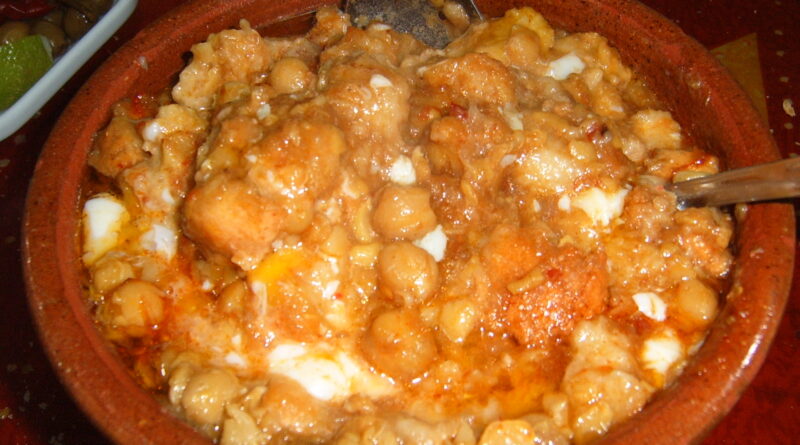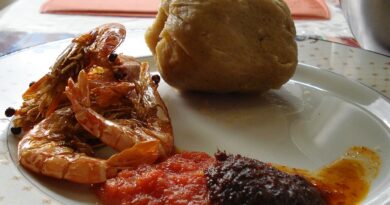Lablabi
Lablabi: Tunisia’s Iconic Chickpea Soup
When you think of Tunisian cuisine, your mind might drift towards couscous, spicy harissa, or a range of delicious Mediterranean dishes. However, one dish that embodies the warmth and heartiness of Tunisian street food is Lablabi, a simple yet flavorful chickpea soup that has earned its place as a staple in the Tunisian diet. This humble dish, often enjoyed for breakfast or lunch, is not only beloved in Tunisia but also offers a rich narrative about the intersection of tradition, frugality, and bold flavors.
Lablabi is more than just a meal; it’s an experience that connects people to the rich culinary heritage of Tunisia. Despite its simplicity, this dish has a fascinating history, complex layers of flavor, and a deep cultural significance that makes it worthy of being celebrated around the world.
History of Lablabi
The origins of Lablabi are deeply rooted in Tunisia’s history, reflecting the blend of cultures and influences that have shaped the country’s cuisine over the centuries. Like many traditional foods, Lablabi was born out of necessity. It is a dish that is based on inexpensive, accessible ingredients like chickpeas and bread, which are staples in many Mediterranean and Middle Eastern cultures.
Lablabi’s origins can be traced to the rural and poorer communities of Tunisia. Chickpeas, or garbanzo beans, were easily grown and stored, providing a source of protein in regions where meat was scarce or expensive. Over time, Lablabi evolved from being a simple, utilitarian dish to something much more flavorful and intricate, reflecting the creativity of Tunisian cooks who used spices, olive oil, and lemon to elevate its taste. Today, it is a beloved street food served in markets and eateries across Tunisia, particularly in the winter months when its warming properties are most appreciated.
Cultural Significance of Lablabi
In Tunisia, food is about more than just nourishment—it’s about community. Lablabi reflects this sentiment perfectly. It is often considered a communal dish, one that is shared among friends, family, and neighbors. The act of making Lablabi is straightforward, but its preparation encourages interaction. In traditional settings, it is made in large pots, served to guests or customers with a variety of condiments, allowing each person to customize their bowl to their liking.
Lablabi is also unique because it is one of the few Tunisian dishes typically eaten for breakfast. In many Mediterranean and Middle Eastern cultures, breakfast is a light affair, often consisting of bread, cheese, or yogurt. However, in Tunisia, Lablabi is a popular morning meal, especially in the colder months. Its richness and warmth make it a perfect start to the day, providing energy and comfort before a long day of work or travel.
Lablabi is also a dish of frugality. Leftover or stale bread is an essential ingredient in this dish, illustrating a no-waste approach to food. This resonates with the historical context of Tunisia, where people had to make the most of what they had. Even today, this tradition continues, making Lablabi not only a delicious dish but also a sustainable one.
Ingredients and Preparation of Lablabi
One of the reasons Lablabi is so beloved is because of its simplicity. The basic recipe consists of just a few core ingredients: chickpeas, stale bread, olive oil, cumin, garlic, harissa (a Tunisian chili paste), and lemon. Despite its modest ingredient list, the flavors of Lablabi are anything but simple. Each element plays a crucial role in building the dish’s layers of flavor and texture.
Core Ingredients
- Chickpeas (Garbanzo Beans): The foundation of Lablabi. Chickpeas are high in protein and fiber, making the dish filling and nutritious. The chickpeas are typically soaked overnight and then simmered until tender.
- Stale Bread: Leftover or stale bread is torn into pieces and placed at the bottom of the bowl. The bread soaks up the broth, adding heartiness to the dish. Stale bread is used to prevent waste, but it also adds a unique texture to the soup.
- Olive Oil: A key element of Tunisian cuisine, olive oil is drizzled over the dish for richness and flavor.
- Cumin: A signature spice in Lablabi, cumin provides a warm, earthy flavor that complements the chickpeas and adds depth to the broth.
- Garlic: Crushed garlic is often mixed into the broth, adding a pungent and aromatic element.
- Harissa: No Tunisian dish is complete without harissa, the fiery chili paste that gives Lablabi its kick. Diners can adjust the level of spice according to their preference, making the dish as mild or as hot as they like.
- Lemon: A squeeze of fresh lemon juice is added just before serving, providing brightness and acidity that balances the richness of the olive oil and chickpeas.
Optional Toppings and Customizations
While the basic ingredients are always the same, Lablabi is often personalized with various toppings and condiments. This is part of what makes it so popular—no two bowls are exactly alike. Common additions include:
- Tuna: In Tunisia, canned tuna is a popular addition to Lablabi, offering an extra source of protein and a bit of umami flavor.
- Capers and Olives: For a salty, briny punch, capers and olives are sometimes added.
- Boiled Eggs: Soft-boiled or hard-boiled eggs are a common addition, making the dish even heartier.
- Parsley and Mint: Fresh herbs like parsley or mint add a burst of freshness and color.
- Vinegar: Some variations of Lablabi include a splash of vinegar, adding tanginess and depth to the broth.
How to Make Lablabi at Home
While you can find Lablabi on the streets of Tunis or in local cafes, it’s also a dish that is easy to recreate at home. Here’s a basic recipe to get you started:
Ingredients (Serves 4):
- 1 cup dried chickpeas (or 2 cans of chickpeas, drained and rinsed)
- 4 cups water
- 4 slices of stale bread, torn into pieces
- 4 tablespoons olive oil
- 1 tablespoon cumin
- 2 cloves of garlic, minced
- 2 tablespoons harissa (adjust according to taste)
- Juice of 1 lemon
- Salt and pepper to taste
Optional Additions:
- 2 boiled eggs, halved
- 1 can of tuna
- Capers, olives, parsley, mint for garnish
Instructions:
- Prepare the Chickpeas: If using dried chickpeas, soak them overnight in water. The next day, drain and rinse the chickpeas. Place them in a large pot with 4 cups of water and bring to a boil. Reduce the heat and simmer for about 45 minutes to 1 hour, or until the chickpeas are tender. If using canned chickpeas, simply drain and rinse them, then warm them in water on the stove.
- Prepare the Garlic and Harissa: In a small bowl, mix the minced garlic, harissa, cumin, and a pinch of salt. You can add a little bit of olive oil to create a paste-like consistency.
- Assemble the Bowls: Divide the torn pieces of bread between four bowls. Ladle the hot chickpea broth over the bread, allowing it to soak in. Add a spoonful of the garlic-harissa mixture to each bowl and stir to combine.
- Add Olive Oil and Lemon: Drizzle each bowl with olive oil and a squeeze of fresh lemon juice. Stir well to ensure that the flavors are evenly distributed.
- Optional Toppings: Add boiled egg halves, tuna, capers, olives, or fresh herbs as desired. Each person can customize their Lablabi according to their taste.
- Serve: Serve the Lablabi hot, with extra lemon wedges and harissa on the side for those who want more heat or acidity.
Nutritional Benefits of Lablabi
Lablabi isn’t just flavorful; it’s also incredibly nutritious. The combination of chickpeas, olive oil, garlic, and lemon creates a dish that is high in protein, fiber, and healthy fats while being relatively low in calories. Chickpeas, the star of the dish, are a great source of plant-based protein and are rich in iron, magnesium, and folate, making Lablabi a particularly good choice for vegetarians and vegans (when tuna and eggs are omitted).
Olive oil, a cornerstone of the Mediterranean diet, provides heart-healthy monounsaturated fats that are known to reduce inflammation and lower the risk of chronic diseases like heart disease. Garlic is renowned for its immune-boosting properties, and the lemon adds a dose of vitamin C, aiding digestion and providing antioxidants.
Harissa, while spicy, also contains capsaicin, a compound found in chili peppers that can boost metabolism and provide pain relief. Together, these ingredients form a dish that is not only filling and satisfying but also packed with nutrients that promote overall health.
Lablabi in Modern Culinary Trends
In recent years, Lablabi has started to gain international attention as more people become interested in global street foods and plant-based eating. Its simplicity, versatility, and emphasis on whole foods align with many modern culinary trends, such as the move towards sustainable, plant-based meals and the desire for dishes that are both healthy and flavorful.
Lablabi is also appealing to those looking for budget-friendly meals that don’t skimp on flavor. Its reliance on inexpensive ingredients like chickpeas and bread makes it a great option for those trying to eat well on a tight budget, while still enjoying a meal that feels rich and indulgent.
Conclusion
Lablabi may have humble beginnings, but its cultural significance, nutritional value, and bold flavors have secured its place as a beloved dish in Tunisian cuisine. Whether enjoyed as a quick breakfast, a hearty lunch, or a comforting winter meal, Lablabi is a dish that warms both the body and the soul. Its simplicity makes it accessible to home cooks around the world, while its rich history and diverse toppings offer endless opportunities for personalization.
As more people around the world discover the joys of Tunisian cuisine, Lablabi stands out as a dish that is both timeless and adaptable—a true representation of the heart and soul of Tunisia’s culinary heritage. Whether you’re a seasoned chef or a novice in the kitchen, making a bowl of Lablabi is sure to transport you to the bustling streets of Tunis, where the scent of cumin, garlic, and fresh lemon fills the air, and the warmth of a hearty chickpea soup provides comfort and satisfaction.



